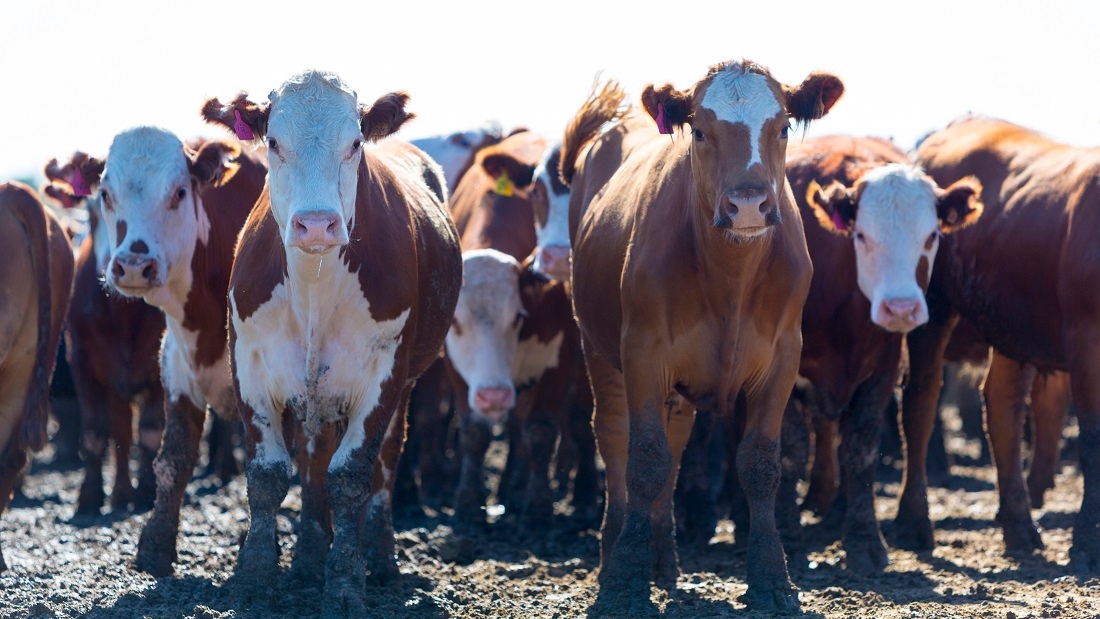Air Pollution

Most people assume that industry and transport are the main causes of air pollution, but agriculture is actually the single biggest cause of air pollution in Europe; contributing more than residential energy use or power generation. As food production continues to expand to meet the world’s growing appetite for meat, fish, eggs and dairy, emissions from livestock farming continue to rise. Reducing meat, fish and dairy production means reducing air pollution – and that could mean the difference between life and death for millions of people every year.
Air pollution is a major concern for public health, causing millions of premature deaths every year. In 2016, 91% of the world’s population were living in areas where the air quality guideline levels were not met. The World Health Organisation (WHO) says that outdoor air pollution – in both cities and rural areas – was estimated to have caused 4.2 million premature deaths worldwide in 2016.2WHO. 2018. Ambient (outdoor) air pollution. https://www.who.int/news-room/fact-sheets/detail/ambient-(outdoor)-air-quality-and-health
The impacts of agriculture
Agricultural air pollution comes mainly in the form of nitrogen-containing compounds, such as ammonia (NH3), which enter the air as gas from heavily fertilised fields and livestock waste. When these nitrogen compounds combine with pollutants from industry, they form tiny, solid particles small enough to invade even the smallest airways. These ‘particulate pollutants’ can stick in the fine lung tissue of children and adults, causing breathing difficulties, damaging heart and lung function and can cause premature death. An increasing body of evidence suggests that this process is now a leading cause of air pollution in Europe, much of the US, Russia and China.6Bauer SE, K Tsigaridis and R Miller. 2016. Significant atmospheric aerosol pollution caused by world food cultivation. Geophysical Research Letters. 43, 5394-5400.
In Europe, the eastern US and regions west of Beijing, agriculture is the biggest single cause of air pollution as nitrogen compounds from fertilisers and animal waste drift over industrial regions.2Bauer SE, K Tsigaridis and R Miller. 2016. Significant atmospheric aerosol pollution caused by world food cultivation. Geophysical Research Letters. 43, 5394-5400. In Europe, while emissions from local transport and industrial activities are important contributors, it has been proven that agricultural ammonia emissions are a major driver of air pollution.7Vieno M, Heal MR, Twigg MM et al. 2016. The UK particulate matter air pollution episode of March-April 2014: more than Saharan dust. Environmental Research Letters. 11, 044004. In the UK, ammonia from livestock is the main contributor to air pollution from agriculture, with cattle providing around half of the ammonia emitted.8Defra. 2018. Air pollution from agriculture. https://uk-air.defra.gov.uk/assets/documents/reports/aqeg/2800829_Agricultural_emissions_vfinal2.pdf
Particulate matter (PM) is the term used to describe solid particles in the atmosphere. Their potential for causing health problems is directly linked to their size. PM2.5 are fine, inhalable particles with a diameter of 2.5 micrometres or smaller. The average human hair is about 70 micrometres in diameter – making it 30 times larger.
Threat to health
Public Health England says that air pollution is the biggest environmental threat to health in the UK, with between 28,000 and 36,000 deaths a year attributed to long-term exposure. There is strong evidence, they say, that air pollution causes the development of coronary heart disease, stroke, respiratory disease and lung cancer and exacerbates asthma.17PHE. 2019. Review of interventions to improve outdoor air quality and public health. https://assets.publishing.service.gov.uk/government/uploads/system/uploads/attachment_data/file/795185/Review_of_interventions_to_improve_air_quality.pdf
A report published by the Royal College of Physicians and the Royal College of Paediatrics and Child Health, estimates a higher number, saying that more than 40,000 people a year die prematurely in the UK due to air pollution. They suggest that the adverse impact on public health caused by pollution costs the UK economy more than £20 billion per year; almost 16% of the current annual NHS budget.18Royal College of Physicians. 2016. Every breath we take: the lifelong impact of air pollution. Report of a working party. London: RCP. www.rcplondon.ac.uk/projects/outputs/every-breath-we-take-lifelong-impact-air-pollution
Since 2013, ammonia emissions have slightly increased in the UK, driven largely by the intensification of agricultural production. This trend may increase further due to the projected increases in food demand to feed an expanding population.5PHE. 2019. Review of interventions to improve outdoor air quality and public health. https://assets.publishing.service.gov.uk/government/uploads/system/uploads/attachment_data/file/795185/Review_of_interventions_to_improve_air_quality.pdf This crisis should be declared a public health emergency, but while politicians argue about when to ban the sale of petrol and diesel cars, the problem of how to control pollution from agriculture remains largely ignored.
Whilst cutting down on industrial pollution from coal-fired power stations and using more efficient vehicles (electric cars) will help, the nitrogen compounds from agriculture can combine with other environmental particulates with major consequences. For example, dust from the Sahara desert combined with airborne nitrogen compounds in the UK and contributed to a major pollution event in 2014. This episode was widely perceived as being a ‘natural’ phenomenon, but scientists writing in the journal Environmental Research Letters say the main cause was agricultural ammonia emissions from Europe mixing with local pollution from industry and traffic. They claim perceiving the event as a natural phenomenon led to a missed opportunity to inform the public and provide robust evidence for policy-makers about the real causes of pollution. Reducing agricultural emissions in Europe would, they say, have marked benefits in reducing air pollution in the UK.3Vieno M, Heal MR, Twigg MM et al. 2016. The UK particulate matter air pollution episode of March-April 2014: more than Saharan dust. Environmental Research Letters. 11, 044004. This demonstrates that reducing pollutants from industry and transport may not be enough to reduce air pollution sufficiently – emissions from agriculture have to be reduced too.
Similar, but more severe pollution episodes have been seen in China and other fast-growing economies.19Oh HR, Ho CH, Kim J et al. 2015. Long-range transport of air pollutants originating in china: a possible major cause of multi-day high-PM10 episodes during cold season in Seoul, Korea. Atmospheric Environment. 109, 23-30.20Yan RC, Yu SC, Zhang QY et al. 2015. A heavy haze episode in Beijing in February of 2014: characteristics, origins and implications. Atmospheric Pollution Research. 6, 867-876.21Zhang QY, Yan RC, Fan JW et al. 2015. A heavy haze episode in Shanghai in December of 2013: Characteristics, origins and implications. Aerosol Air Quality Research. 15, 1881-1893.22Zhou M, He G, Fan M et al. 2015. Smog episodes, fine particulate pollution and mortality in China. Environmental Research. 136, 396-404. While a major proportion of urban PM2.5 in these regions arises from local transport and industry emissions, agricultural ammonia emissions have also been identified as key contributors.3Vieno M, Heal MR, Twigg MM et al. 2016. The UK particulate matter air pollution episode of March-April 2014: more than Saharan dust. Environmental Research Letters. 11, 044004. The pollution episodes in China (and other fast growing economies) may be more severe than those so far experienced by the UK, Paris and other parts of Europe,23Gualtieri G, Toscano P, Crisci A et al. 2015. Influence of road traffic, residential heating and meteorological conditions on PM10 concentrations during air pollution critical episodes. Environmental Science and Pollution Research. R 22 19027-19038. but if nothing changes, it could well be a sign of things to come.
A 2015 study published in the journal Nature estimated that outdoor air pollution leads to over three million premature deaths around the world each year (lower than the WHO estimate of 4.2 million). They claim that if current trends continue, the number of deaths could double by 2050. In their study, they set out to identify which outdoor pollution sources are the most harmful: residential and commercial energy use, agriculture, power generation, industry, biomass burning, land traffic or natural sources (such as dust storms). They found that emissions from residential energy use (low-quality fuels used for cooking, heating and waste disposal), led to a high number of premature deaths in populous parts of Asia, including China, India, Bangladesh, Indonesia and Nepal. Agricultural emissions (such as ammonia from animal husbandry and fertiliser) were the leading cause of premature air pollution deaths in the Eastern US, Europe, Russia, Turkey, Korea and Japan, followed by traffic and power generation emissions.24Lelieveld J, Evans JS, Fnais M et al. 2015. The contribution of outdoor air pollution sources to premature mortality on a global scale. Nature. 525 (7569) 367-371.
Cleaning it up
Reducing carbon dioxide emissions generally requires a switch to solar- or wind-generated energy, which also reduces sources of particulate air pollution. Introducing cleaner technologies to reduce air pollution therefore has the bonus effect of reducing greenhouse gas emissions.
The good news is that strategies to fight both air pollution and the climate crisis go hand in hand. Not only does reducing air pollution reduce greenhouse gas emissions, it could mean the difference between life and death for millions of people every year. A win-win solution for both public health and the planet.




